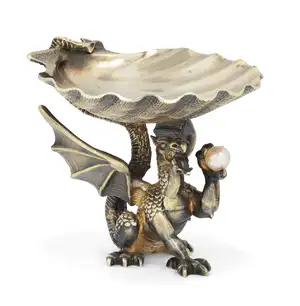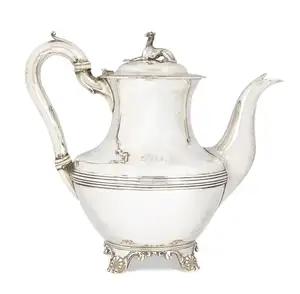Wednesday 20 March 2024
A Japanese silver and mixed metal Aesthetic Movement bowl. Import marks for Cornelius Brabrook...
View MoreLot 14
Description
A Japanese silver and mixed metal Aesthetic Movement bowl.
Import marks for Cornelius Brabrook Pare,
Birmingham, 1878.
Of shaped, circular form, the textured foliate sides applied with mixed metal animals including butterflies and a crab, the interior lightly gilded, some gilding to exterior also, 5.5cm high, 11.9cm wide, gross weight approx. 6.2ozt
Lot Footnotes
Christopher Dresser was a leading figure in the Japonisme movement in the West, and his efforts to promote Japanese art and design led him to set sail for Japan in 1876-1877. This was the first visit to Japan by a European Designer, and Dresser was commissioned to form two collections of 'reliable tutorial value': one for the London based importer of Japanese wares, Londos & Co., and the other for Tiffany & Co. of New York. Charles and Louis Tiffany commissioned him to bring back some 8000 objects from Japan, from which their own craftsmen could take inspiration and obtain technical knowledge. These were delivered by Dresser on his return journey from Japan in 1877.
Dresser is known to have worked as an advisor to the firm of Londos and Co. (a partnership between Cornelius Brabrook Pare (whose sponsor’s mark is on this bowl), Peter Charles and John Reynolds). The partnership was dissolved in 1879. The hallmarks on this bowl (Birmingham, 1878, Cornelius Brabrook Pare) suggest that it was one of the items brought back by Dresser for Londos & Co. in 1877.
Based on the design of an interesting Tiffany & Co. chocolate pot made in New York in 1979, it seems reasonable to conclude that a similar bowl may have included in the collection that Dresser amassed for Tiffany. The chocolate pot features similar applied mixed metal animals including a crab (see pg. Fig. 8.13, pg. 262 In Pursuit of Beauty. Americans and the Aesthetic Movement, The Metropolitan Museum of Art, New York, 1987, and https://www.metmuseum.org/art/collection/search/20121).
The book describes this chocolate pot in the following words: The dramatic and difficult combination of copper and silver is seen in a graceful Tiffany & Company chocolate pot made in 1879. The form of this piece is Western, yet it is covered with a reddish patina and decorated with sea-life motifs, suggesting Japanese print sources. Crabs and lobsters cast in silver are affixed to the copper surface, which has been soldered and hammered to the silver body of the pot. (Pg. 262)
In providing Tiffany with such a wealth of examples, David Hanks asserts that Dresser ‘acted as a catalyst for the influence of Japanese art on American manufacturers and designers (Gorham and Tiffany, for example, both produced items of silverware applied with mixed metals). Dresser marvelled at the way in which Japanese craftsmen combined beauty and utility in the goods they made for everyday use, and he incorporated a number of Japanese themes into his own creations, including butterflies, frogs, cherry, reeds and insects. His motto ‘In Pursuit of Beauty’ became virtually synonymous with Japonisme.
Dresser devoted several pages of his book Japan: Its Architecture, Art, and Art Manufactures to descriptions of the virtues of Japanese metalwork, of which a few are included below.
Our first acquaintance with Japanese (metal) manufacturers revealed their skill in the casting of metals...The great peculiarity which I noticed in the Japanese method consisted in a fresh model being made for every work produced...It will be seen that this process, although laborious, gives variety and interest to the works produced ; and while all such methods must seem to us to involve an unnecessary expenditure of labour, I yet think that the Japanese gain as much as they lose by their processes. The Japanese method of casting gives a certain amount of variety in the work produced, for no two objects are precisely alike (pp. 417-420)
Pg 428 The Japanese have more nearly achieved the production of colour harmony in metals than any other people; and in many of their works we see gold, silver, copper, zinc, black-metal, tea-urn bronze, green bronze, and other metals and alloys brought together; and not only brought together, but so arranged that their colours are brightened by reflected lights, and brought into harmony by skilful juxtaposition.
Pg 429: One other point connected with Japanese metalwork is worthy of most careful consideration, namely, the various textures given to metals. We are too fond of bright surfaces, and not unfrequently prefer glitter to repose; but to the Japanese, glitter is vulgar.
References: Christopher Dresser and Japan, (Catalogue Committee, 2002); Christopher Dresser and the Arts of Japan, Harry Lyons & Chris Morley (RSA Journal, Vol. 148, No. 5496 (2001), pp. 90-91); Japan: Its Architecture, Art, and Art Manufactures, Christopher Dresser, London, 1882; Old Bailey Record “t18841020-998”,1884; In Pursuit of Beauty. Americans and the Aesthetic Movement, The Metropolitan Museum of Art, New York, 1987; The Metropolitan Museum of Art: https://www.metmuseum.org/art/collection/search/20121, New York).
Fees & VAT
Buyer's Premium
The buyer shall pay the hammer price together with a premium thereon of 26% up to £20,000 (31.2% inclusive of VAT), 25% from £20,001 - £500,000 (30% inclusive of VAT), 20% from £500,001 thereafter (24% inclusive of VAT). The premium price is subject to VAT at the standard rate.
VAT
VAT is not charged on the hammer price unless it is stated that there is 'VAT applicable on the hammer price at the end of the description. Buyer's premium is subject to VAT.(ARR) - ARTIST'S RESALE RIGHT
Qualifying living artists and the descendants of artists deceased within the last 70 years are entitled to receive a re-sale royalty each time their work is bought through an auction house or art market professional.
It applies to lots with hammer value over £1,000 as follows:
0 to £50,000 - 4%
£50,000.01 to £200,000 - 3%
£200,000.01 to £350,000 - 1%
£350,000.01 to £500,000 - 0.5%
Exceeding £500,000 - 0.25%
ARR is capped at £12,500
Please note ARR is calculated in euros. Auctioneers will apply current exchange rates.
Export of goods
Buyers intending to export goods should ascertain whether an export licence is required before bidding. Export licences are issued by Arts Council England and application forms can be obtained from its Export Licensing Unit. Details can be found on the ACE website www.artscouncil.org.uk or by phoning ACE on 020 7973 5188. The need for import licences varies from country to country and you should acquaint yourself with all relevant local requirements and provisions before bidding. The refusal of any such licences shall not permit the cancelling of any sale nor allow any delay in making full payment for the lot.
Own a similar item?
Request a ValuationReceive alerts about similar lots
Get StartedContinue Browsing
LOT 15
A Russian silver mounted desk blotter. Vasily Naumov (probably), Moscow, 1908-1926. The...
Estimate: £400 - £600
LOT 16
A set of four Chinese export novelty spider's web place/menu card holders. Stamped...
Estimate: £150 - £250
LOT 17
A dragon-decorated Chinese export silver cigarette case. Maker's mark Kun He, retailed by Hung...
Estimate: £120 - £180
LOT 18
A Judith Leiber novelty snail vase. c.2000. Stamped 925. Designed with a perforated,...
Estimate: £400 - £600
LOT 19
A pair of silver pheasant knife rests. Bishton's, Birmingham, 1970. Each knife rest modelled...
Estimate: £80 - £120
LOT 20
A limited edition parcel gilt silver dragon salt. Hector Miller, London, 1982. Designed as a...
Estimate: £150 - £250
LOT 21
A pair of lobed parcel gilt silver salts. Asprey & Co., London, 1993. Of circular form with...
Estimate: £300 - £500
LOT 22
A William & Mary style silver plated salt. Duchess of Sutherland Cripples Guild, c.1910. Of...
Estimate: £80 - £120
LOT 23
A pair of Regency parcel gilt silver salt cellars. Charles Price, London, 1819. The cast...
Estimate: £400 - £600
LOT 24
A pair of Queen Anne silver salt cellars. James Goodwin, London, 1713. Of circular form with...
Estimate: £300 - £500
LOT 25
A George II silver salver. William Peaston, London, 1748. Of circular form with a shell and...
Estimate: £300 - £500
LOT 26
A George III silver goblet. Henry Chawner, London, 1789. The tapering bowl raised on a chased...
Estimate: £500 - £800
LOT 27
An early George III silver sauce boat. Probably Thomas Whipham & Charles Wright, London,...
Estimate: £300 - £500
LOT 28
A William IV silver coffee pot with greyhound finial. Richard Pearce & George Burrows, London,...
Estimate: £350 - £450
LOT 29
A Queen Anne West Country silver trefid spoon. John Elston, Exeter, 1708. The oval bowl with...
Estimate: £400 - £600
LOT 30
A Charles I silver Apostle spoon, St Philip. Possibly Thomas Hodges, London, c.1640. The...
Estimate: £1000 - £1500
 Newsletter Signup
Newsletter Signup
 Keyword Alerts
Keyword Alerts
Would you like to receive personalised keyword alerts when new catalogues go live. If so, please indicate these below
Set a password to save your keyword alerts
Passwords are a minimum of 7 characters and must include an upper case letter, a lower case letter, a number and a special character (e.g., !@#$%^&*).






























